#i've been learning a lot about flow and composition
Text

A full moon shines, an omen of safe travels.
#art#fantasy art#dragon#dragons#caspar david friedrich#friedrich#This one's a study of: Two Men Contemplating The Moon#man i love drawing fantasy ruins but i needed a break for at least one illustration lol#so fun to study the shapes in the environment#i've been learning a lot about flow and composition#even in super organic landscapes#fantasy creatures#travelers#dragon art#fantasy illustration
4K notes
·
View notes
Text

I've been learning a lot about alpha inheritance/lock in krita lately and it's kinda revolutionizing the speed and flexibility of drawing comics. being able to move around the ink frames "and" the frames for the best composition flow at the click of a button is enormous.
this video was the most helpful breakdown.
13 notes
·
View notes
Text
The Witch and the Beast Anime's Outlook
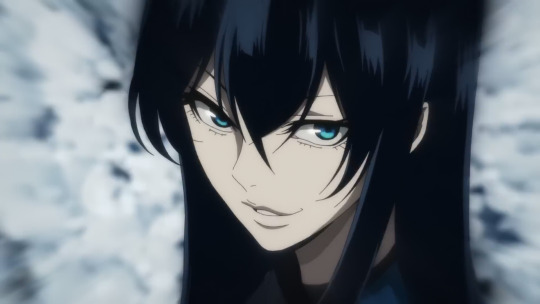
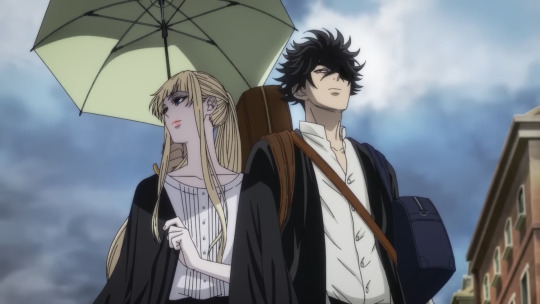

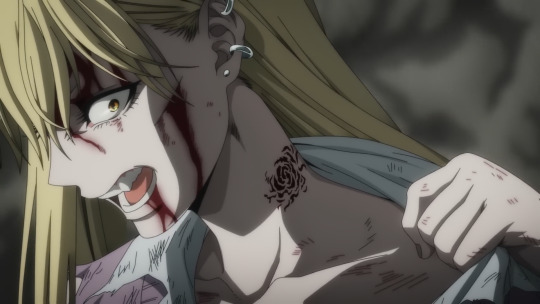
I've finally awakened from my anime slump and have been catching up on a lot of anime. I learned my lesson about trying to do too much and watch too many shows. Therefore, I'm going to limit the number of anime I watch going forward so that I actually have time to write about them. I was barely finding time to watch the shows I've decided to begin, let alone write about them. I'm feeling a bit more comfortable now after grinding a ton, and I would like to talk about one of my anxiety-inducing and highly anticipated anime, The Witch and the Beast.
If you didn't know, The Witch and the Beast is possibly one of my favorite mangas of all time, if not my absolute favorite. It's very under the radar, and I think if you love the world of Ancient Magus Bride or enjoy The Case Study of Vanitas and want a darker twist with a highly aesthetically pleasing art style, I think you should give it a try. But back to the anime, like most people when their manga get adapted, when I first heard it was announced, I was extremely excited—after all, who wouldn't be? Getting an anime adaptation is probably one of the things you wish for your favorite series. After months of confirmation, we finally got the first teaser PV, which looked fine (I did have some complaints about it, but it was mostly fine). We learned that the studio working on it is Yokohama Animation Lab.
If you've been watching anime recently, you might have come across some of Yokohama Animation Lab's works, as they have been quite active since 2017. They have produced visually appealing shows such as Miru Tights and Lapis Re:LiGHTs. However, more recently, they've released shows with less-than-stellar visuals, like Kingdoms of Ruin, The Great Cleric, and Rail Romanesque 2. Even their highest-rated show at the moment, The Genius Prince's Guide to Raising a Nation Out of Debt, doesn't exactly have amazing animation quality; it's more of a passable-looking show. Which made the studio choice a huge large concern for me, as The Witch and the Beast is a series that relies a lot on its visuals. It's an integral part to the enjoyment of the series, it's a series that relies on its aesthetically pleasing artwork for the sake of showing off the characters and the worldbuilding.
However, studios aren't people, and I didn't want to adopt an incredibly negative outlook because the people working on it will change over time, and anime relies heavily on freelancers. The quality of the anime you see from individual studios will differ greatly. But there is a difference in that aspect to an extent in Yokohama Animation Lab, much like in this interview said. They are looking to become more of an in-house studio rather than freelance due to the costs of subscription programs. Oogami Yuuma emphasizes that while digitalization in anime is often viewed as a cost-cutting measure, setting up the required digital environment can be initially expensive. So they are seeking a cost-effective solution. His statement, to this day, still rings pretty true. If you look at the staff for Yokohama's series episode by episode, you might be surprised that a majority of the episodes do seem to involve in-house staff more than the average anime. However, that doesn't seem great when their recent quality, especially in shows like Kingdoms of Ruin, has been rather atrocious. In all visual aspects, animation (incredibly lacking), storyboarding (low quality and not engaging, scene flow to eachother like a slideshow), compositing (incredibly jarring). The only thing I can praise about it is its art direction.
I mentioned Kingdoms of Ruin specifically as it does share several key staff with The Witch and the Beast and I think it's just worth mentioning. Now with all that being said you can see how my worry for the adaptation was incredibly large at the time (in the fact it still is), but I've lessen my worry of it when I tried to look at the individual staffs working on this show and the stafflist of the recent Yokohama shows.
Unfortunately, I did sit through some episodes of Kingdoms of Ruin (do not recommend), and I found it interesting that the staff list for the show was rather small at times— a lot of animation directors, but not many actual animators. For example, one of the action-heavy episodes only had a singular key animator. It's as if they didn't have enough staff. I would say that Kingdoms of Ruin is of lower quality than even the average Yokohama series.
This got me thinking, where are the staff going? Well, there are several options. Yokohama has some upcoming releases, but unquestionably, their biggest series coming out is Whisper Me a Love Song (which I also love), followed by The Witch and the Beast. The other two upcoming series are not nearly gaining as much traction.
This is all just a guess that likely won't amount to anything, but just the type of series that The Witch and the Beast is and the fact that it's the series coming right after Kingdoms of Ruin, I think it's possible that it will end up benefiting from the staff that was missing from that series. I feel like Yokohama will try to put more effort into this series, considering they didn't opt for their usual newbies and completely in-house directors; rather, they got a veteran director in Takayuki Hamana.
Hamana has been in the industry for an incredibly long time, but chances are you haven't heard of him. Recently, he directed Power of Hope Precure Full Bloom, which had a lot of great cuts from what I've seen. He has also recently finished working on the Sorcerous Stabber Orphen series, which didn't receive the best reception (more so for its rushed nature rather than visuals). Additionally, he worked on the Rakudai Majo movie recently, which unfortunately doesn't have an English release yet.
While it's not like these recent shows have the best ratings on MAL or other sites, it tends not to be because of the visuals but rather the story, over which he likely didn't have much control, especially in the case of Precure. He's very much capable of delivering a good product if the source material and the script are solid. Beast Player Erin is his highest-rated work, but he also has shows like Library Wars or Arte, which I know many people like.
In studios like Yokohama, I always tend to favor veteran directors, as they have been in more situations and will likely be able to find a way to maintain quality better than newbie directors; their industry connections should allow them to get external staff to help out. Hamana has shown evidence of this many times, even in the rushed release of Sorcerous Stabber Orphen and the hazardous release pace of each season. They all still managed to have well-animated cuts here and there, and that has been a trend for a majority of his series.
If you just put some of his randomly directed series on Sakugabooru, for example, you'll find that every one of his series tends to have cuts listed there. I think this is a testament that Hamana, while he won't always make the best shows, knows who to bring in and how to manage them for the more important parts of a show. He's a very consistent director, and I think he's someone who could and likely will benefit The Witch and the Beast's studio situation a lot in terms of its production quality. Whether you'll like his directing style (which tends to remind most of 2008s anime) is an entirely different matter, but he is a source of hope in terms of its production quality.
And you know with all this talk of Yokohama and the many people, like me worried for The Witch and the Beast's quality, while I may not be a fan of the many visual direction choice that has been shown in the PV, we haven't gotten any real evidence that the production quality or animation quality will be bad. From the most recent PV and likely final PV, the character designs look fairly well-maintained for the most part. Close-ups are impressive. I also like the expressions for them, strong eye work. Overall CAD work seems good.
Though, essentially, there isn't a lot of animation shown, so that aspect of it can't really be touched on at the moment. So, conclusion? It's a really lazy thing to say since I made you read through this long spew of mine, but I don't really know either. It really is a wait-and-see situation; however, I do encourage you not to write it off just because of the studio choice. A good pick in a director like Hamana, and some other staff I haven't even touched on, like the character design by Hiroya Ijima, and the external studio situation in terms of releases, provide hope for the series, and I genuinely believe that, at the very worst possible version of the series, it probably will be about the Genius Prince's visual quality, which isn't great but won't be a complete disaster. However, with Hamana at the helm, I do expect a better quality show than that.
I'll see you guys next time on January 11th when the show comes out, because, trust me, I will be there.
13 notes
·
View notes
Text
i'm happy that video essays are a popular format on youtube now. i've loved the genre for years and, with care, it's a reliable source of accessible education.
that said, the popularity of video essays on youtube makes me feel like my brain is leaking out of my ears. it is so easy to immediately tell when an author has no actual investment in the genre and sees it merely as a vehicle for #Content™️©️®️
There are three basic qualities I see suffering the most for this
1. Length
I see so many of these newer channels pumping out 8 hour pieces that are closer to exhaustive book reports then they are tight, well written examinations of something and, while I LOVE the diversity inherent to the video essay format, this is a terrible way to explore a topic. It's boring, lame, and extremely profitable.
Quinton Reviews is a good example; I like his work occasionally, his recent thing on Dan Schneider was genuinely pretty good. It did still suffer from the resulting pacing sickness from overloading on information and underloading on composition & organization. Wendigoon is an even better example. Most "iceberg" style vids also are (not u jan misali. never u.)
Also, there's no defined rule for the length of a video essay. They can be 5 minutes long or 5 hours, flash fiction or a full-bodied thesis. Shots of tequila or a whole bottle of wine can both get you drunk.
2. Pacing
Obviously related to length but this is another problem; video essayists have always struggled with this and it got worse recently anyways.
A lot of that "information overload" is to blame. It's important that, when researching, YOU come to a strong, nuanced understanding of a topic through disparate sources. It is, by nature of the format and genre, an extremely bad idea to try and make your audience learn the information the same way.
We don't need a thousand sources spread across several dozen sentences, we want the 3-4 (max) best sources on a given subtopic concisely synthesized into a coherent idea.
Use music, jokes and relevant graphics to make this information as engaging and interpretable as possible without sacrificing accuracy. It's okay to abridge and note that you were, in fact, abridging. We don't need to know every detail about every single thing loosely related to the topic.
Dan Olson from "Folding Ideas" is a good example of this. His script writing and camera work does an extremely good job of creating effective flow with an appropriate amount of detail & nuance. So, pacing, basically.
3. Topic
U can tell some of these jamokes don't give a fuck or shit about the thing they're discussing. Worse still when it's some inane internet drama they're recounting like its "news."
To be clear: the best video essays are OFTEN on topics you have no previous interest in. Robolox_oof.wav by HBomberguy is an easy example. This shit is a complete mess thematically but, because the author engages deeply and effectively with the topic, it literally doesn't matter. It's an insanely good video you should spend all 2 & 1/2 hours in rn. Go. Watch it.
Nor is internet drama a bad topic to cover. You're allowed, encouraged really, to discuss the weird bullshit people do to each other but like... this is closer to a soap opera than it is a national news headline. Looking at you, "Turkey Tom" or whatever the fuck your name is.
There's something to be said, too, for how quick people are to make an essay about a still moving situation. I know the algorithm is an insatiable maw of content hunger but, counterpoint, ONLY MAKE A VIDEO WHEN YOU CAN ACTUALLY DESCRIBE WHAT HAPPENED. If there's reasonable suspicion stuff isn't done, SHUT THE FUCK UP. It's okay if you misjudge a timeline here or there, you're allowed to admit fault and correct yourself, but, like, cmon.
Also something to be said about how quick so many essayists have ALWAYS been to talk about someone else's business without permission, particularly intimate partner violence.
4. Style/Presentation
Video essays are an extremely novel format, particularly for education, so there's a genuine debt of easy-to-adopt styles. And, because of the recent growth, there are a lot of new people entering the space with very little experience in it.
That said, the next time I hear that fucking "influencer cadence" I'm gonna EXPLODE. You know the one, they slow down towards the end of a sentence to lend "gravitas" and overarticulate every. single. word. to, idk, build credibility?
It's shallow and obnoxious and I hate it. Nothing makes me skip a video faster than a boring intro & a predictable cadence. Be honest about the way you speak. If you struggle to create rhythm & flow with your voice, use music! Seriously, music sampling is a super valid method, most indie artists would be JAZZED to have their stuff in parts of their video. A lot of orchestral stuff is in the public domain, especially a lot of famous "classical" works. Put Beethoven's 5th in your video about potato farming in russia, God might not be real and if she is she'd ALSO think it's funny.
Another problem: predictable cuts & generally uninspired editing. I know editing is a pain in the ass but, like, it IS still a creative process. You do have space to do interesting stuff here and, if you can't focus for that long, literally just make a shorter video.
It's okay if 95% of your transitions are purely functional, the trick is to make those 5% REALLY silly to keep your audience on their toes.
5. Tone
You don't need to be "an authority" on a topic to make a good essay about it. It helps but, as long as you're clear & honest about the limits of your understanding and you've done your due diligence, you almost certainly will be fine to talk about anything you want.
If you want to build credibility quickly, consider starting with disambiguation instead of dry recitation. Dates matter less to me than actually understanding a topic better. Even better if you come across like another autistic person infodumping about whales or w/e.
I'd keep going but my phone's gonna die. U get the gist. Lots of format problems that algorithm-brain is exacerbating.
4 notes
·
View notes
Text
Artist Interview
Happy Boxing Day! I was tagged by @you-are-so-much-better-than-that in this artist interview.
1. Do you post on AO3? If so, how many works do you have on AO3? If not, where do you post?
I do post on AO3 as Suzy_Queue. I have two art galleries there, one for general art and one for Kinktober 2022.
2. What is your total art count?
If you count art done for other people's stories, headers for my own stories, and Gallacrafts pieces, it's around 150.
3. What are your top 5 pieces by likes/kudos?
I use this cool website to get my full Tumblr stats. According to them:
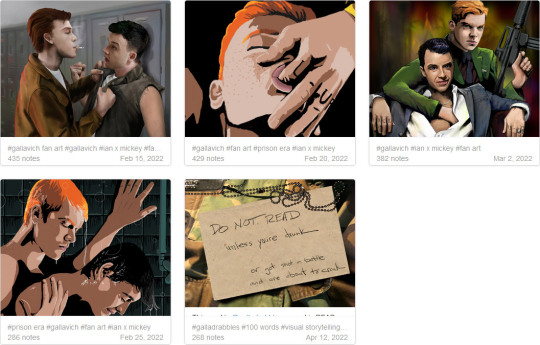
4. Do you respond to comments? Why or why not?
Yes! Although I'm not the fastest at it.
5. What is your current fandom, and what was the first fandom you drew for?
Currently, it's Gallavich all the way. The first fandom I remember drawing for was Teenage Mutant Ninja Turtles, making my own comics. (they were 7th-grade-girl bad).
6. Have you ever received hate on any art?
Nope, people are very supportive, even on pieces that I know aren't that great.
7. What’s a fandom/ship you haven’t drawn for yet but want to?
I can't really think of any.
8. What’s your all-time favorite ship?
The one that has lived in my brain for the longest part of my life is Han/Leia.
9. Do you draw outside of fandom?
Yeah! I was an art major in college. I've been a professional artist for 20 years and have created art for book covers, movie posters, album covers, logos. I go to figure drawing sessions at a local art school and am in a nature journaling group. I've displayed my horror art at conventions around the country.
10. What’s the an art piece you’ve drawn that came out completely differently than you expected?
This was the first piece I ever drew on a tablet with a pressure-sensitive pen. It was an experiment to learn the tools. I had no idea how it would look, and it turned out all right.

11. Do you draw smut?
Yep! There's some smut in this gallery.
12. Have you ever had any of your art stolen or copied?
Not that I know of.
13. Have you ever collaborated on a piece?
I've created art for stories working with the author, but I've never co-drawn a piece of art. Unless you count playing Exquisite Corpse with my children.
14. What’s an idea you have that you have yet to draw?
Oh, I have a lot. The one I think about most is a picture of Ian and Mickey in a lineup at jail, looking disheveled, hung over, and completely in love.
15. What are your drawing strengths?
I like my compositions a lot, the flow of items throughout the picture. I feel like I'm good at drawing what I see in a realistic way, whether it's a photo or real life.
16. What are your drawing weaknesses?
Drawing from memory/imagination. I have to have reference photos of what I'm doing or I go off the rails. I need to develop more trust in my own style and lean into weird proportions and my own skewed vision.
17. What’s your favorite art piece you’ve drawn?
I'm quite partial to this book cover art I did. It's spray paint, pastel, and acrylic. It's about 4 feet tall.

18. What is one thing you’d like to tell people about your art that they might not know?
Just because I've been doing it for a while doesn't mean I'm not still learning every day.
19. What inspires or motivates you to create for fandom?
I have a lot of emotional energy churning below the surface. Creating art and fics helps get it out. It's a much more positive outlet than letting it brew.
20. And finally, can you describe your process a little? Do you have a favorite place to draw? Do you play something in the background? Do you do research or just go for it? Give us a little insight.
I have a basement office where I write and draw. I bought a new table this year which I absolutely love. I do most of my creative work between 9-11 pm after the rest of my family has gone to bed. I do love music and play it a lot while I draw.
I research a ton. I spend a lot of time making photo compositions for every piece I draw, which are collages of body parts and other images.

Thank you so much for the tag for this interview!
27 notes
·
View notes
Text
Practical Coursework Journal (Reflection Journal) - Year 3 Final Semester
Week 2:
Last week marked the beginning of the second semester of my third year, and it was pivotal in shaping my journey toward the final recital performance. This second week started off with Sara's class and I delved into a thorough vocal warm-up routine, which helped warm up my voice and also go over the vocal techniques again.
After the vocal warm-up, Sara outlined the requirements for the recital performance. She urged me to assemble a band and commence the process of selecting songs for the repertoire. Thankfully, during the winter break, I worked on making new songs, in addition to retaining four songs from the previous semester.
As Sara and I discussed the potential setlist, I found myself leaning towards utilizing the songs that I sang last semester alongside the newer compositions I had been refining. However, I felt a bit uncertain about the recently created songs. I spoke to Sara about my intention to think it through and also what to see the new songs I come up with over this semester.
This juncture served as a moment of reflection, where I want to make sure that each song conveys my artistic expression. I wanted to remain open to exploration and want to have a good recital performance.
Week 3:
After my initial session with Sara, I reached out to my bandmates to confirm their availability for the upcoming performance. Meanwhile, I began brainstorming new ideas for songs.
My songwriting process typically starts with thinking about a theme or emotion I want to talk about before writing my lyrics and composing music. So often, inspiration strikes while watching TV shows—whether it's a character's dialogue, a scene, or even just the title of the show. As I get ideas from TV shows I ensure that the ideas I choose resonate with me personally, as it's crucial for me to feel connected to the lyrics I write.
In my second year, I found myself putting a lot of pressure on myself when it came to songwriting, which affected my confidence to sing on stage. However, over the winter break, I dedicated time to learning and practicing, and I've noticed a significant improvement. Now songwriting has become more enjoyable, and ideas now flow naturally without feeling forced.
During our second session, I shared a couple of new songs with Sara, "Worth the Wait" and "This Way." Her feedback was encouraging—she appreciated my songwriting style and the direction my music was taking. Her words validated my identity as an artist and gave me the confidence to explore songwriting further.
Through this process of discussing my new songs, I had a brief conversation with Sara through which I learned an important lesson during this session: the value of taking feedback selectively. While Sara's comments were useful, I realized that ultimately, it's up to me to decide how I want my songs to sound. This was a new concept for me, as I've always been accustomed to incorporating every piece of feedback or comment I receive. Learning to trust my instincts and make decisions that align with my artistic vision was more important. It's a new skill I'm eager to develop further as I continue to grow as a musician.
Week 4:
During this week's session, I started with my vocal warm-ups as usual. Sara then asked me to bring in some songs I wanted to work on together to refine my vocal techniques. It's been quite a journey for me to grasp these techniques, especially since I come from a background in Indian Classical music. It wasn't until my summer break in 2023 that I really began to understand them fully. That's why I make it a point to do Monday's personal practice of vocal warm-ups in class with her to ensure I'm on the right track.
Sara has been incredibly supportive and patient throughout this process. She truly understands me as a student, and I'm grateful for her guidance in teaching me vocal techniques that I can also apply to my Indian Classical training.
During today's session, I shared with Sara a Hindi song I've been practicing at home called "Sau Aasmaan." Additionally, she asked me to revisit another Hindi song, "Raabta," which I hadn't felt confident about in the past. I used to struggle with it a lot, and it was a song I tried to avoid because of that. But today, I approached it with a different mindset. I realized that avoiding a song won't help me improve—it's better to face it head-on and work through the challenges.
Link for Sau Aasmaan:
youtube
Link for Raabta (female version):
youtube
With Sara's guidance, I sang both songs with karaoke tracks, and I was pleasantly surprised. "Raabta," which used to be a struggle, felt much easier this time. Having a better grasp of vocal techniques made a significant difference. While there were still areas to improve upon, it was clear that my efforts in mastering the techniques were paying off. This session served as a reminder of the importance of facing challenges rather than avoiding them. It was a valuable opportunity to apply what I've been learning and receive immediate feedback on my progress.
Week 5:
By this week, I had added a few more new songs to my repertoire, including "Worth the Wait" and "This Way," which I performed at the Friday pop workshop. Interestingly, while "Worth the Wait" felt solid, "This Way" left me feeling a bit uncertain due to its unconventional structure. Recognizing this, I decided to make new songs that better aligned with my vision.
"Worth the Wait" is about learning to understand that through waiting you can get the best and learn to wait and pray for love.
"This Way" is about me being an introverted person. My reference song for this song was a song from the Netflix movie "Purple Hearts" and the song was "Feel It Still" by Sophie Carson.
Link to Feel it Still:
youtube
I shared the video of my Friday performance with Sara, seeking her feedback. After some discussion and reflection, I made the decision to include "Worth the Wait" in my setlist. Additionally, I introduced Sara to my latest creation, "Dancing under the Moonlight," a song that deviated from my usual style but still was very close to my writing style. My inspiration sparked after coming across a picture of the autumn season when I stumbled upon a captivating image. In the picture, the road was blanketed with vibrant autumn leaves, illuminated by the soft glow of streetlights. That scene sparked an idea in my mind: a tender moment where a girl dances with her love beneath the flickering light of a streetlamp on a crisp autumn night. My vocal style for this song was completely different and the inspiration for the vocal style was the Korean song "Villan" by Stella Jang.
Link of the song Villian:
youtube
Sara's encouragement and support were invaluable—she expressed genuine happiness at witnessing my growth both vocally and in my songwriting journey over the past few months.
I explained to Sara my intention to incorporate "Dancing under the Moonlight" into my setlist, recognizing its unique contribution to showcasing my artistic evolution. Sara's guidance has consistently pushed me to strive for excellence. Through my years at Lasalle and under Sara’s guidance, I've come to realize the importance of embracing feedback and criticism. In the past, I was hesitant to accept critique and wasn't very open-minded about getting feedback from anyone fearing it would impede my progress. However, through experiences like performing at Lasalle's Friday performances, I've learned to view criticism as a catalyst for growth. Each instance of feedback, whether positive or constructive, represents a step forward in my journey as an artist, helping me understand my strengths and weaknesses more deeply. It's a journey of self-acceptance and continuous improvement that I'm grateful to be on.
Week 6:
Over the weekend, I started working on a new song called "Day Dreamer," which I shared with Sara during our session this week.
The reference for this song was a Turkish drama romantic-comedy drama called "Erkenci Kuş" which translates to Day Dreamer, I kind of used that idea and made this song. This song is about a girl just daydreaming about the person she loves. For my song, the first half of the song refers to the Turkish drama and the second refers to a Chinese drama called "Amidst the Snowstorm of Love" which is a romantic and sports drama.
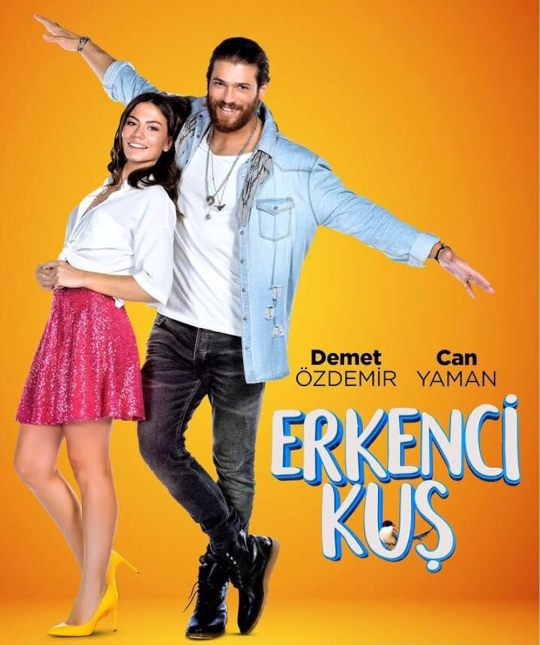
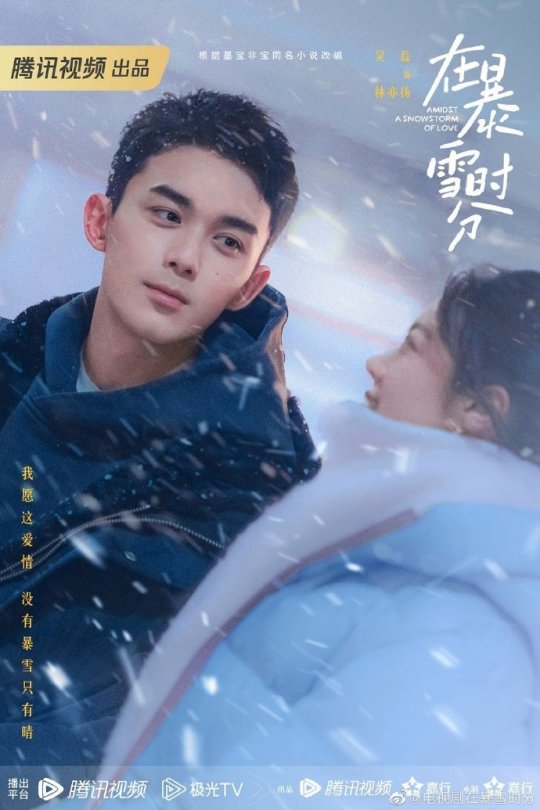
Her feedback was positive overall, but she pointed out some things that could be changed like in the tune of the second verse compared to the first. She suggested making some adjustments to ensure consistency and enhance the memorability of the melody for both verses.
Taking Sara's advice, after class I revisited the second verse and made some changes. I kept the chords and melody the same for the first half but introduced some variations to bring freshness to the song. This change not only addressed Sara's feedback but also added depth to the composition, especially since the song lacked a bridge.
Later in the week, I had the opportunity to perform "Day Dreamer" at the Friday Pop workshop. The reception was fantastic, with everyone enjoying the catchy chorus and praising the songwriting. It was encouraging to receive such positive feedback, not only for this song but for all the songs I've been working on recently.
Throughout this process, I've learned to balance hard work and enjoyment in songwriting. It's essential to put in the effort to learn and practice, but equally important is to maintain a sense of enjoyment and avoid putting unnecessary pressure on myself. I've noticed that when I approach songwriting with joy and passion, it reflects in the final product—there's a certain energy and authenticity that shines through in the lyrics. It's a lesson I carry with me each time I embark on a new songwriting journey.
Week 7:
This week, I finally solidified my band lineup. It took some time, especially with the drummer situation, but I managed to find a replacement who could commit to playing with us. The process of reaching out to potential band members was quite stressful for me, highlighting the importance of having a network of contacts in the music industry. It's clear to me now how valuable those connections can be in times of need.
Once the band was finalized, I communicated with each member to coordinate rehearsal dates that suited everyone's availability. After some discussion, we settled on scheduling our rehearsals for Fridays from 6:30 pm to 8:30 pm. This allowed us to secure a practice room and ensure everyone could attend without any conflicts.
With the rehearsal schedule in place, I turned my attention to finalizing the setlist. After careful consideration, I made my decisions and shared the song drafts with the band. Providing them with access to the songs beforehand allowed everyone to familiarize themselves with the material, ensuring a productive rehearsal session.
Reflecting on the week's activities, I've learned the importance of effective communication and organization when managing a band. By staying proactive and keeping everyone informed.
Week 8:
This week, most classes were put on hold for project week, but I still had a session with Sara. Since there was one class from last semester that hadn't been used, Sara suggested we could either have a recital rehearsal or focus on vocal warm-ups. So I worked on vocal warms. During my personal practice, I started working on all my songs for the recital so that I remember the lyrics for the performance.
This week, I had my panel presentation, and I was pleasantly surprised by how much smoother the feedback session went compared to last semester. It was a huge relief to hear that my work was clear and well-defined.
The main suggestion I received was to ensure that my topic, "Hindu devotional music and its effects on the human mind," can be understood by someone who isn't familiar with Hinduism. Additionally, I was advised to present my points as objectively as possible. These insights will help me refine my work and make it more accessible to a broader audience.
Week 9:
This week, I focused on refining my rock song "Teen Days," which is part of my recital setlist. I've been stuck with this song since the winter break, often feeling stuck and unsure of how to proceed. After some searching, I thought I found a helpful reference song which was a J-pop song "Damn" by Fujii Kaze, but it didn't quite fit the band setup or the vibe I wanted. However, during Thursday's pop workshop rehearsal, I stumbled upon another rock song which is a Hindi Bollywood song called "Pichle Saat Dinon Mein" which had the right feel and setup, which proved to be a great source of inspiration.
The song references links:
1. "Damn" by Fujii Kaze -
youtube
2. "Pichle Saat Dinon Mein" from the movie Rock On -
youtube
During the Friday pop workshop, I performed "Teen Days" and received constructive criticism that could enhance the song. Admittedly, rock isn't my usual style, and I've noticed myself straining my voice to match the intensity I think the genre requires. Taking these comments into account, I began exploring other rock songs to better understand the genre.
During this exploration, I revisited a song my father and his cousins had composed in their mid-20s. Over the winter break, I heard the original version and felt inspired to remake it, tweaking chords and lyrics to improve its flow. This week, I worked on a draft of the song and received positive feedback from my family. I also sought Sara's opinion, who appreciated the simplicity of the song but noted that the lyrics didn't quite align with my usual style—a point I agreed with. Since this isn't my original song, I aim to maintain its authenticity while enhancing certain aspects to elevate it.
After carefully making my songs and understanding the different styles I have written in and worked around, I plan to continue exploring these styles even more and understanding how they fit into English pop music writing. I'm also eager to delve into writing more in Hindi, and I aim to incorporate elements of pop and Indian vocal styles into my music. It's a journey of self-discovery and artistic exploration that I'm excited to embark on.
Week 10:
During this week, I scheduled my first band rehearsal for Friday, so during Monday's session with Sara, we went through my song list together and got all my chord charts corrected. I wanted to make sure the chord charts for the band were clear and easy to understand. It was important for me that the band members could grasp the songs properly. Sara suggested starting the rehearsal with the three old songs from last semester which were "Live the Fullest", "Tere Sang" and "Hopeless Romantic" to refresh our memories before diving into the four new ones. Surprisingly, during the rehearsal, we managed to go through five songs smoothly. Despite having a new drummer in the band, everyone adapted quickly and played their parts well. For the new songs, like "Worth the Wait," which had only been recorded acoustically before, I closely worked with the band to see how they would sound in a full setup. I felt confident in the outcome, knowing that each member of the band was skilled in their instrument.
I made sure to listen to their suggestions and ideas during the rehearsal, and understanding that this was an opportunity for me to learn and grow before stepping into the music industry. Over the past three years at Lasalle, I've had the chance to work with students from various musical backgrounds. This experience taught me the importance of clear communication within a band. When everyone understands their roles and communicates effectively, the result is a cohesive performance that reflects the vision of the song. I've also learned the importance of voicing my opinions and ideas within the band. If I'm not comfortable with a certain aspect of the music, it's essential to speak up. This ensures that I enjoy singing the song and that the performance truly represents me as an artist.
Being in an environment surrounded by talented individuals has undoubtedly helped me grow artistically. Each interaction and collaboration has contributed to my development, shaping me into a more confident and communicative musician.
Week 11:
This week, I arranged the second band rehearsal, focusing on working on the last two songs in my setlist: "Dancing under the Moonlight" and "Day Dreamer." During my Monday session with Sara, we went over the chord charts for these songs, making necessary changes and corrections to ensure clarity. Unfortunately, the drummer couldn't make it to the rehearsal, so we worked on a rough draft of the songs and recorded our progress. I then shared the recordings with the drummer to give him an idea of the song structures and the tone we were aiming for in each piece.
Despite the absence of our drummer, the rehearsal proceeded smoothly. We managed to work through the songs effectively, and they were beginning to take shape just as I had envisioned. It was a satisfying experience to see everything coming together, and I felt optimistic about our progress.
Reflecting on the rehearsal, I realized the importance of adaptability and teamwork in a band setting. Despite facing a challenge, we found a solution and continued to make progress toward our goal.
Week 12:
Today was a busy day as Sara graciously accommodated two sessions to assist me with my 3rd recital rehearsal. I had requested some extra time during our usual session for vocal warm-ups and practice.
During our regular session time, we focused on vocal warm-ups and improvising out the tricky parts of some songs where I had been struggling. It was a productive session, and I felt more confident in those challenging sections afterward.
Then came the rehearsal with Sara observing for an hour. With my band, we started by tackling the songs that posed vocal challenges. Sara provided feedback not only on my vocals but also on areas where the band could enhance their performance. Her insights were invaluable and helped us refine the songs further.
Once Sara left, with the band I went through the remaining songs. While there were still some areas where the band could practice a bit more, overall, it felt like we were on the right track. Reflecting on the day's rehearsals, I appreciate Sara's guidance and the opportunity to fine-tune our songs. Each rehearsal brings us closer to delivering a good performance at the recital.
Week 13:
In today's session with Sara, I felt the need for a vocal reset. Ever since my third rehearsal, I've been experiencing strain while singing. During rehearsals, I tend to push my vocals, singing loudly over the band, which has led to issues with my voice. Sara suggested a change in approach, advising me to refrain from singing excessively during rehearsals. Instead, she emphasized the importance of allowing the band to focus on refining their parts without straining my voice.
After the vocal reset, we concentrated on three specific songs: "Live the Fullest," "Hopeless Romantic," and "Teen Days." These songs hold significance as they are the first three in my setlist and have been causing strain on my vocals. The primary goal of today's session was to regain control and sing these songs with ease.
Through continued practice and Sara's guidance, I worked on singing these songs without exerting unnecessary pressure on my voice. It was a reminder of the importance of prioritizing vocal health in my rehearsals. Moving forward, I'll be mindful of striking the right balance between vocal intensity and preservation, ensuring that I can deliver my best performance while safeguarding my voice.
This week, we had our fourth recital band rehearsal, and the main goal was to run through the songs in the order I had planned for the performance. It turned out to be a successful rehearsal, as all the band members were well-prepared and clear about their parts. Any confusion was resolved.
I’m pleased to say that we accomplished our objective efficiently, wrapping up the rehearsal in just one hour as I had hoped. It was reassuring to see everyone working together seamlessly, and it boosted my confidence in our readiness for the upcoming recital. Reflecting on this rehearsal, it's evident that our hard work and dedication are paying off. Now I current have one final recital rehearsal on 12th April which will be basically to go through all the songs properly and try timing the whole thing so that I am aware of how long it will take.
As I reached the end of the final week of the Pop workshop, I couldn't help but pause and reflect on the profound growth and learning that have marked my three-year journey at Lasalle. It's been a journey of transformation.
Throughout the first two years, I had the opportunity to explore a multitude of genres, experimenting with different styles and sounds. This exploration was crucial in helping me discover my own unique voice and artistic identity by year three. I'm deeply grateful for this period of exploration, as it laid the foundation for me to truly understand and embrace the style that best suits my vocals.
Moreover, the collaborative nature of the various workshops I have been a part of allowed me to connect with various musicians, each bringing their own expertise and perspective. These collaborations have not only enriched my musical understanding but have also taught me the importance of teamwork and communication in creating music at a professional level.
As I look back on this journey, feel grateful for all the opportunities I've been given and the lessons I've learned. It's been a privilege to immerse myself in the rich language of music and to grow alongside such talented individuals. All these experiences and connections that have shaped me into the artist I am today.
0 notes
Text
Making It Workshop #4 (5/5/23)
I really liked Nghiem Ta's presentation and found her job super interesting! I've never learned about what goes into a book designer's job but I've always been interested in it so this was a really great opportunity.

It was really cool to see how Nghiem blocks out sections in the picture book for art and sections for text. Just from a glance, I can see that the compositions of each spread are varied nicely and flow into each other.

Seeing the illustrator's sketches added into the spread is also really cool, and gives me a much better sense of how a picture book actually comes together. It's super cool to see how the artist actually works within the blocked out dimensions without it seeming stiff or awkward.


The difference from sketch layout to the final printed spread is also really valuable. It's interesting to note the small changes like the movement of a card from horizontal to vertical, the corner flourishes becoming gears, and the pose of the magician changing slightly. Overall though, the composition has remained very close to the original sketch, showing that it's important to lock down the layout but okay for smaller details to end up changing a bit.


I also loved getting to see the more technical and organizational parts of Nghiem's job like the scheduling and file building. I'm pretty familiar with these two aspects because of my Prattler job and as a mod for several fanzines, so it gives me some confidence that I would be able to handle this kind of job.
I feel like the publishing industry is much harder to gain information about than animation because most professionals in the industry are not as vocal about their careers (online at least). I think there's also an age difference between the two industries. There's a lot more demand for work in animation as opposed to publishing which can operate with a much smaller design team. I personally think this leads to less young people (who are more transparent and active online) getting hired, and contributes to a feeling where publishing can lag behind current day sentiments/trends by more years. I really appreciate having Nghiem's expertise and her willingness to share information her career with us, and it definitely helps me to understand what I'm interested in doing in the future.
0 notes
Note
4. How do you choose which fics to write?
11. Do you write scenes in order, or do you jump around?
12. Do you outline your fics? If yes, how detailed are your outlines? How far do you stray from them?
17. Do you have a writing routine?
18. Do you enjoy research? Which fic of yours required the most research?
21. Do you prefer writing chaptered fics or one-shots?
80. I have some story ideas but I don't know how to write them. How do I write those stories?
4 and 12 were already answered here!
11. Do you write scenes in order, or do you jump around?
Bruh, I can't even write a sentence in order. That said, lately I've been trying not to get TOO into the details of later scenes or later parts of scenes. I find that when I do, I end up having to scrap most of it because details I add in earlier make the later details not work.
So I guess my process is… I just write down any and all ideas I have as I think of them, no matter when in the scene or story they're supposed to go. But when I sit down to really hash out a full scene, I start from the beginning and use my random later ideas as a rough outline, knowing that I'll probably have to tweak or outright remove most of them once I get there.
It's also really, really common for me to leave placeholders in my scenes to come back to later. Extremely common. You have no idea. My early drafts are more placeholder than fic. The placeholders can range from standing in for "X action(s) need to happen here" to "I need another line or two of dialog here for this to flow right but I can't think of what" to "literally just cannot think of the word I'm looking for and don't want to break my flow right now to scour a thesaurus". Then later I gradually go back and fill in the placeholders, usually in several passes. Honestly, writing for me is more like putting together a puzzle than anything.
17. Do you have a writing routine?
The biggest "routine" thing for me is just that I try to make sure to write SOMETHING every day. On bad days, maybe that's as little as half a sentence, but at least that's half a sentence more than I had the day before. Most days, once I get started, I can keep going for at least an hour.
More specifically, I usually write in the mid-afternoon and/or late evening, laying on my living room floor for some goddamn reason. (Ok, I know the reason: it helps me to sit somewhere other than my usual chair so my brain has a cue that I'm in writing mode and not fucking-around-online mode.)
18. Do you enjoy research? Which fic of yours required the most research?
I love research and probably do way more of it than is really necessary. I tend to get real deep into ridiculous topics like snake reproduction or the chemical composition of semen, learning all sorts of details that don't end up reflected in the final fic at all.
I've done the most research for the lil buddy series, since it's set in the real world and I want to try to make sure my depiction of, for example, the Texas foster care system circa the mid-1980s is at the very least not so inaccurate as to be offensive. I still feel like it's probably not all that realistic, but I'm trying. (I also now know a hell of a lot about the timeline of VHS releases of The Muppet Show, which is obviously a very important detail that would have thrown people right out of the fic if I'd gotten it wrong.)
21. Do you prefer writing chaptered fics or one-shots?
I prefer one-shots. Pretty much all of my chaptered fics started out as one-shots that got out of hand. tear at me was supposed to be a one-shot. Playing House was supposed to be a one-shot. Hell, the entire lil buddy series (including several WIPs that I haven't posted yet) was supposed to be a single one-shot.
As mentioned before, I'm not good at, like… outlining. So working out how to structure and organize chaptered fics can be a challenge for me. This has been a major problem for my longest WIP, which I just have not been able to get to come together at all.
80. I have some story ideas but I don't know how to write them. How do I write those stories?
It's hard for me to answer this since I'm not sure what exactly you're struggling with. But I will say that sometimes I have an idea that feels Too Big or Too Important and I can't get a handle on how to write it in a way that I feel satisfied with.
In those cases, it helps me to just… set aside the big idea for the moment and focus in on one small aspect of it. One scene or one conversation that I feel like I can write. Or maybe a moment from the backstory to help explore the characters' motivations or the setting. Or even shift my focus for a while to some other small idea entirely, if I'm getting too frustrated metaphorically banging my head against this one.
(A few of my fics are actually a result of exactly the above process. Sugar-High Shenanigans is actually a scene from the aforementioned long fic that I've never finished. the perfect prayer was me exploring Bro's character when I felt stuck on tear at me. The lil buddy series is just the result of me breaking a longer fic idea into smaller, more manageable chunks.)
Basically, start out with something smaller in scope. Give yourself space to just try things out and not be perfect.
Along those lines, writing drabbles can be a fun exercise. Like, if you only have 100 words to convey an idea or a dynamic, what do you focus in on? It really forces you to distill the idea down to its essence. And they're pretty low-pressure, too, because even if you don't feel like you get it quite right, oh well, it's only 100 words; you can always try some other approach to the same idea another time.
I don't know if any of that helps, but yeah!
0 notes
Note
hi hello i was rereading some quantum meruit pages and i was wondering! where did you learn comp like this!! its crazy distinctive and cool (you now own the primary colors, legally) and i'm curious abt ur process 👀
first of all thank you so much i really appreciate it!!
i wrote on this subject a little while back but that was almost a full year ago at this point so i've got some more to say and don't really feel like that post was super concise. that post i think tends to cover mostly the design philosophy but less about the actual mechanical execution of it so ill try and give a little of that now
i've been wanting to do a big writeup about composition for awhile now but i've been finding it really hard because the truth is it's more or less a completely intuitive process for me. i just go until it feels right. but i think the main reason my compositions look the way they do is because of my approach to tangents so i'll just talk about that + a couple other tidbits as best as im able here
there’s a lot to be said about tangents. this post is a REALLY good primer for thinking about tangents but i’ll boil it down even more to basically my own personal guiding rule: no two edges should ever touch, and no three edges should intersect.
essentially;
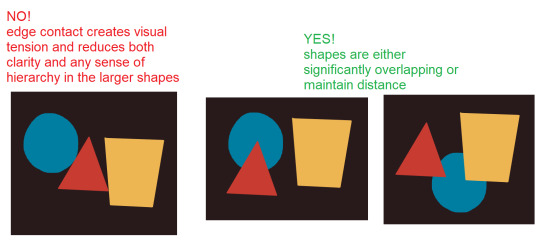
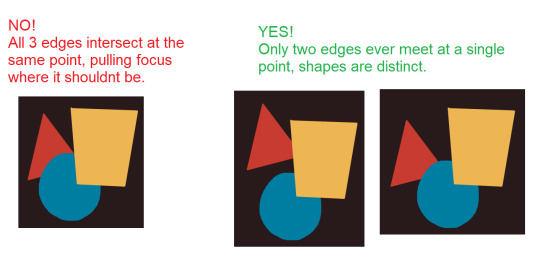
i will almost never break these two rules. unless i’m feeling really tired and just want to move on without micromanaging everything i will make sure that every shape on the page is organized by these principles. i would rather break the perspective or the stuff i’m drawing and make it less technically accurate if it means i can avoid a tangent.
obviously, the more shapes you have in an image the MUCH harder this becomes. gonna try and break this down with some page examples so you can see how that sort of manifests outside of a deeply abstracted visual
heres a page that has some of the most overlapping shapes out of every page in this whole shebang

overall, i managed to do a decent job keeping everything distinct but i started getting sloppier as things got more crowded and i got dick of working on it.here you can see highlighted in green every instance where i think elements get too close to sharing an edge or intersecting improperly. not a huge amount but you can see theres still a significant presence of it. but theyre all extremely small

chances are probably no one noticed these problematic areas except for me, especially the really small ones. so what’s to gain by being so anal about it? well the answer for me at least is that it allows heavy geometry to exist while still feeling organic. when things intersect abruptly or share edges it forces them into a sort of implied grid almost, and really makes everything feel much more artificial and lacking in depth than you want it to.
by being VERY careful about where and how things are allowed to touch both on the micro scale and the macro scale, it just allows me to make sure that the very flat and static images and objects in my panels still feel like theyre flowing because the way your eye is lead Between these objects doesn’t follow a stark geometric grid
heres a couple of breakdowns of what this actually looks like for larger compositional elements. when you break the ‘panels’ so to speak down into just their base shapes you can see the way theyre arranged to carefully follow these rules of overlapping and intersecting

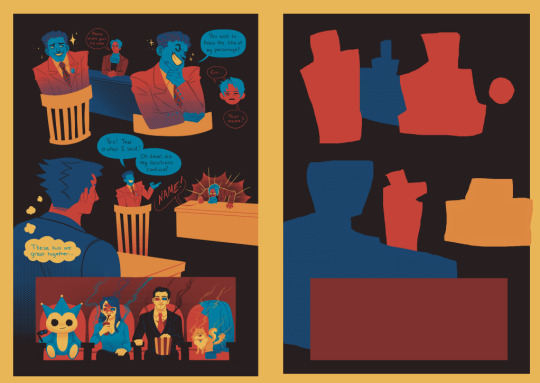
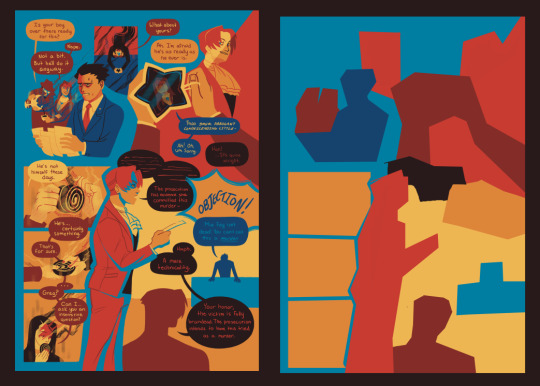
(the phoenix ‘panel’ and mia and greg ‘panel’ in that last one have a shared edge on the left side, but thats intentional as theyre sharing a physical space)
of course, theres minor mistakes on every page. but to just be really actively considering this while i work helps me place the objects in a pleasing way
my speech bubbles also have to follow these same rules of overlap, which helps dictate the flow of the eye through the page. the way elements flow into each other is also REALLY important - you should understand exactly what paths you want your audience’s eye to follow. with comics you have the luxury of speech bubbles for that. a lot of my pages get away with disjointed paneling because of the flow of the speech bubbles.
a lot of the time this ends up looking like a big S curves to take full advantage of the proportions of the page
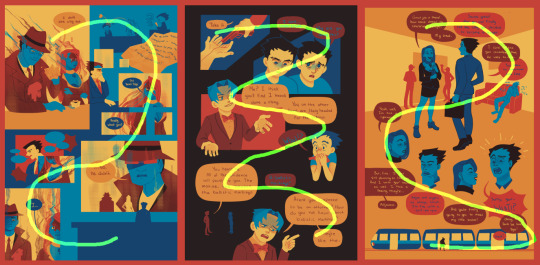
if i wasnt working with speech bubbles, there’d be other visual elements here that i’d use to guide the eye in a similar fashion.
heres some pages that have stuff going onto them thats closer to the way i’d direct the eye in an illustration. its super obvious and heavyhanded but that doesnt make it bad. its doing what its supposed to.

i also think understanding exactly what you’re trying to get across with the composition is critical, because the page layouts themselves convey information, rather than just being simple scaffolding that your actual visuals rest on top of, if that makes any sense.
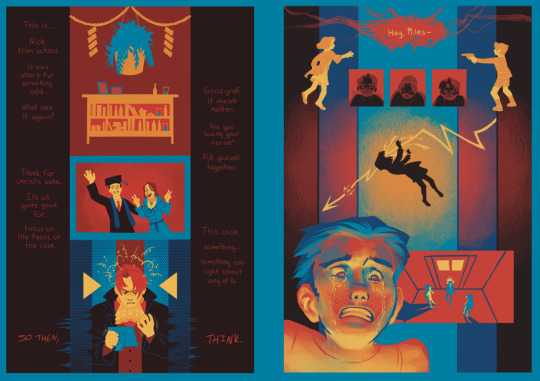
for example these pages get forced into these strict nesting verticals, which not only provide a claustrophobic visual as things are sort of crushed between them, but theyre designed to mimic elevator doors. this is a visual motif used specifically for indicating that Edgeworth Is Freaking Out About Shit Right now.
i think that imagery is pretty clear on its own, but since i’m working in a comic format i have the small luxury of being able to establish my own visual language. a composition might not have a clear meaning on it’s first time being shown, but through repetition it becomes shorthand for conveying a certain feeling.
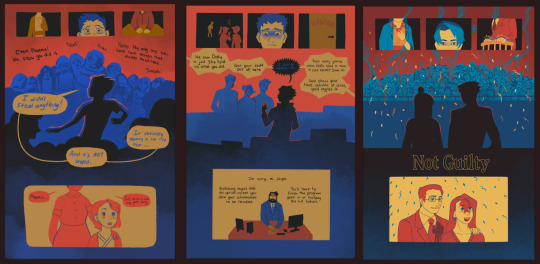
here’s a page composition i keep using for phoenix. none of these pages are particularly special compositionally on its own but by repeating this same visual motif i’m retroactively imbuing it with the narrative significance i wanted it to have. whether or not anyone is consciously picking up on it, there’s going to be a twinge of familiarity every time it’s seen that helps hammer in the character stuff i’m going for.
then similarly theres pages that are designed to interplay with each other on a less 1:1 scale, like these pages of edgeworth and mia which is just the same composition flipped upside down. They’re both supposed to get a feeling of a sort of disempowerment across, but not in the same way.

basically i guess if there’s one takeaway from all of this its to be deliberate
i know i said this is an intuitive process for me but just because that’s the case it doesn’t mean it’s an automatic one. every single element in an image is placed with intent to convey a specific feeling or lead the eye in a specific direction. if youre really thinking about what you’re doing youll get better at accomplishing what youre trying to do. theres no wrong way to do it so you just have to try and figure out what you like.
i hope any of this was helpful !
155 notes
·
View notes
Note
Hi! Widdershins has been my favorite comic for years now, I admire your storytelling so much. I was just rereading, and I wondered how you choose the composition of your panels? They're so dynamic-- you use so many dramatic angles and I hadn't really realized how much energy is conveyed that way. Any tips to an amateur artist?
oh gosh, haha, thank you :) if i'm being honest a lot of my composition stuff now is just kinda natural- i've learned a lot of rules that are jammed into my head after so many years of practice, but i'll try to articulate a few for you.
largely, i try not to keep the "camera" static, so i like to move it about and try out different angles where possible. this isn't necessarily a hard and fast thing you NEED to do while making comics- widdershins is an adventure comic though, so its best to keep it snappy and dynamic, and flipping angles helps that. you run the risk of things looking chaotic though, so i generally try to stick to the ol' 360 degree rule- this means if character A starts on the left of the panel and character B starts on the right, try to keep them in that order, as it reads much smoother that way. you can see me doing that in this recent page here-
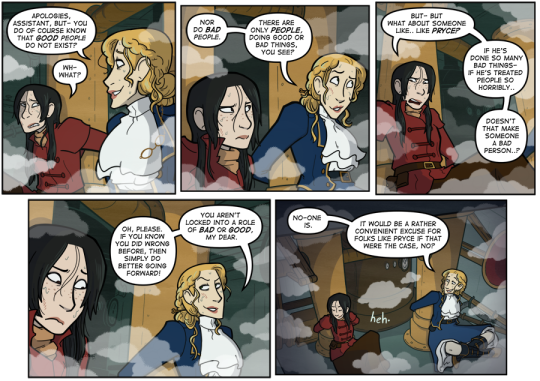
lei is to the left, vee is to the right on every panel. yes i know they literally cannot move but i'd have positioned them similarly were they able to run about, i promise :V
don't treat this as an unbreakable hard and fast rule though, it's really more of a guideline, so don't feel trapped by it. note i flipped vee and lei's positions in this final panel here-

-because it's more vital that the reader gets a good solid closeup on what vee's hands are doing before they read her speech bubbles there.
but trying to keep to the 360 degree rule while still keeping the "camera" in motion can keep visual interest high! you can do some fun stuff too like having characters visibly crossing from left to right to set up the action.


another thing to note on these pages is that it can really help to have your actions- vee's flip, rattaker's swing of the spanner- go from left to right as that follows the direction the reader is reading. it gives more of a vague sense of forward motion, if you get what i mean? this also means you can have the action going in the other direction when you want to convey someone moving backwards-

or having their progress halted, or moving slowly-
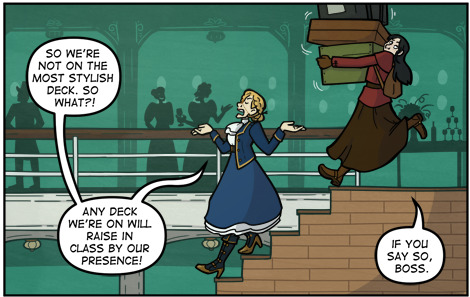
sometimes if it's an intentionally slow paced scene, or something where you wanna show a distinct change in two states, you can keep the camera static, like so-

-since the lack of relative movement can help to highlight a change in scenery or facial expression.
another tiny helpful thing i like to keep in mind is to try to pull out the camera enough to show a full body shot of the characters at least once per page- i call it the boots rule, gotta see a pair of boots on the page to establish where they are in the environment, and not just constant closeups of faces. again this isn't a hard and fast rule, it's something i made up for myself since i found i was doing too many close panels, which got kinda crowded and confusing. if your characters are moving about or changing position though, you do wanna pull back the camera to show where they now are relative to the scene, and keeping the boots rule in mind can help remind you of this.
in general just keep in mind that readability is key, and easily the most important but invisible part of making a comic. you wanna make it so your reader doesn't have any moments of stopping for a second like "huh? which panel is next?" or "when did that guy move over there". consider the flow of your page, how your composition of both art and speech bubbles can follow the way a reader's eye will naturally scan the page, and you're heading in the right direction.
uh, hopefully that helps! if you wanna know anything more specific please ask, i can ramble on about this sorta thing for ages!
78 notes
·
View notes
Note
Heya, I got a question, Artist to Artist, Do you have any advices on starting a series? I've been thinking about starting a series here and i drew some concept art on it already but i have no clue how to start it so any advices?
This is flattering, but I need to first warn you. I have never done a comic series. Even though my story is based on a webcomic and I adore webcomics, I don’t have the patience to draw panel after panel. That being said, I am a good storyteller and I do have some tips.
So first off, choose an idea or story you love. Something you adore because it’ll be what you’ll be spending a lot of time and energy on. You best love what you’re working on plus if you like, it doesn’t matter if other people do or don’t.
Before you start drawing, write the story first. Have a storyline and direction. It’ll save you a bunch of revising and redrawing if you know where you’re going. If you don’t know where to start there, here are some things to help you think:
-What’s the setting? Is there a clear sense of time, place, the mood and vibe of your area. Is it a gothic castle, fantasy forest, crowded city?
-Who are your characters? Are they developed and believable? Do you know their distinct personalities, motivations, and challenges?
- What’s your plot? Does your story follow a natural sequence or arc (background information, rising action, conflict, resolution)? Are there any gaps in these beats that could confuse your readers?
-What’s your point of view? Is it consistent?
-What is/are your theme(s)? What lessons are your characters going to learn in this story?
Once you have your story figured out it’s time to look at your layout. What’s the style you’re going for? How important will color and shading be? It might be a good time to look to some of your favorite series and see how they organized the flow of their pages and panels. If you’re just starting out, I’d say to keep it simple. Find what works for you and flows nicely.
Now to actually draw! My advice is to start with thumbnails. Just quick, messy drawings of the layout for that page and that chapter will be. That way you can see if everything fits on the page without it being overwhelming. The actions and poses are clear, the dialogue fits and it’s easy for the eye to go from panel to panel, dialogue to dialogue. You can organize it and if you have to toss a problematic page out, well it was just a thumbnail. The skeleton of the comic. You didn’t take hours with the lineart or the colors and shading. Leave the complicated compositions for later works too. This is something that will just take practice and will get easier the more you do it.
Last, give yourself some rules. You can experiment but if you are doing a long comic, make some rules for yourself to so can try to be consistent. For your panel layouts, to your page flow, to your character designs. It’s easy to let your style change from the beginning of the comic to later on. It happens to everyone really. But don’t give yourself a character you really struggle drawing because it’ll kill you every time they show up in your story.
And most of all have fun! Love what you do and go for it. I hope this helped a bit with getting started!
#answers#inky answers#inkymystery#the inky mystery#babitim#inky mystery#artists#start with the end in mind
37 notes
·
View notes
Note
Hi! I was just wondering if you could answer an art question?
A problem I've been having with my drawings is that they're not very...lively I guess? Like I notice some of my drawings I've done look a little stiff and static. Do you have any advice on how to go about improving in this area?
oofo this is hard to answer without looking at them! It could be many things. But you talk about stiff and static. It might be something about the pose. Sometimes when we learn to draw something in a certain way and we do it a lot we sort of fall back to it unconsciously more than we'd like to as a sort of comfort zone. For me, when I notice it, drawing from references always helps, even if I end up changing bits of them quite often - I like starting out with something that is close to what I have in mind and that has a nice flow. I will try to keep that energy.
Another thing might be - always related to flow - when i e you have the ground work all looking nice and dynamic and you start adding details on top.
Sometimes you move to polishing and it somehow looks worse even if it's more detailed. Either the things you're now drawing are 'countering' the flow and lines of tension of the original composition (like adding cold water to hot water - it gets lukewarm) or it's for example - when you're drawing clothes and you start prioritizing the details rather than the overall shapes.
I'm working a bit on trying to polish my own stylization and something I try to do is to keep a certain energy and movement to the lines and the shapes, exaggerating them a tiny bit (pushing angles and curves) makes for better expressiveness (that's what they do in animation, they exaggerate shapes to make a certain character give off a certain expressive vibe right away) hope it's somewhat helpful ^^'
7 notes
·
View notes
Note
I know you and that Scorpio guy have venus square Pluto in your composite but I've read so many bad things about it!! Is it true?
No aspect is good or bad in my personal opinion! Some just require more awareness and maturity to handle and maintain but due to the nature of aspects and how they tend to “separate” over time they inevitably get better over time considering the person involved or persons involved are doing what’s necessary to master said aspect.
As for how it affects us in the composite? Ah well In all honesty Pluto squares sun/moon/Venus-but trines mars and mercury in our composite so due to the mercury trine where able to dive into the depth of our problems! That being said Venus square Pluto alone I would say after two or so years in our relationship became noticeable. As I do believe the composite shows the nature of a relationship after some years have passed while the synastry is always “occurring” when you guys are around one another.
But yeah we can both easily obsess over one another and there is a big danger we have for becoming to involved with one another that everyone and everything else seems to fade out. There’s a lot of possession themes and overall intensity. His aqua moon litturly disappears in all seriousness and he can be quite overwhelming and black or white and so can I! There also is a lot of emotional turmoil present between the two of us but once again that mercury trine makes us get over it quickly. But that being said I’d die for him and our love runs extremely deep. And despite our many ups and downs and un-necessary drama it’s only served to strengthen us and make us that much stronger!
This aspect is pretty heavy and dare I say almost like a Saturn square in the composite but it’s not without its many unbelievable perks! •prolific intimacy •sensual and intuitive •a craving and desire for only one another •a deep need for intimacy between one another that can be overwhelming but ah you get used to it •may oversexualize the relationship due to the energy conjured up by the square! •don’t like sharing each other lmao •and jealousy might have to be tackled together as you both would end up having issues with this •deep loyalty •unhealthy addiction to one another but once again you will learn to balance this •you guys might be overly sexual to others as well like the Pluto nature will be very prominate to outsiders •if you do brake up it might not be a “brake up” but more of a “space” thing because at first I’ll tell you this can be a draining aspect but once more as time passes it can actually become energizing.•warm and cuddly! Surprisingly it’s SOO nurturing and you both cannot live without each other but that being said pettiness and cold shoulders are constant when you guys are mad at one another •although sex might be constant it’s not what “sex” is for sex is just used here as an outlet for the intense feelings both of you feel for one another
That being said I love it and love him! It’s been a pretty hard aspect learning to get the hang of but idk now I just to with the flow of it! There are times I get mad about things from years ago and then I feel closer to him after for having that moment of “jealousy” and he has times where he acts out when he’s not getting his required level of devotion from me and litturly shouts my head off and then turns all sweet and cuddly after 😂😂 it’s like such a sitcom aspect but one that adds a lovely amount color and foolishness to your relationship! But you’ll both love one another immensely and it’ll brake your heart not to hear from them be it platonic or romantic.
Hope this helps love ❤️
39 notes
·
View notes